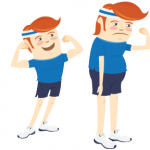Labs on admission were notable for a creatinine of 1.46 mg/dL, which corrected to 0.9 mg/dL with hydration. His hematocrit was 33.4%, down from 40.6% two weeks prior. His reticulocyte index was 0.6%. His alanine transaminase was mildly elevated at 53 units/L. Albumin was 4.1 g/dL. His white blood cell count was 3,400/uL, and his platelet count was 159,000/uL. Urinalysis earlier in the month had 2+ blood, but was negative for blood or protein on admission. C-reactive protein was 0.2 mg/L (0–3 mg/L), and erythrocyte sedimentation rate was 7 mm/hr (0–12 mm/hr). Viral hepatitis and HIV serologies were negative. Creatinine kinase (CK) had been 229 units/L three weeks prior to admission, but had normalized.
Anorexia nervosa can present with a number of symptoms, signs & even lab results that can initially appear consistent with a rheumatologic disorder, such as limb pain, weakness, hair loss, rashes, cytopenias & pathologic fractures.
We considered a number of different etiologies for the underlying process. Inflammatory myositis, such as polymyositis, dermatomyositis and immune-mediated necrotizing myopathies, seemed unlikely because these conditions are usually painless and feature elevated CK and inflammatory markers. Rheumatoid factor, antinuclear antibodies (ANA), anti-dsDNA, antineutrophil cytoplasmic antibodies (ANCA), and anti-glomerular basement membrane (anti-GBM) antibodies had been checked previously and were all within normal ranges. A kidney biopsy performed for hematuria one month previously revealed normal kidney parenchyma.
We next considered non-inflammatory myopathies, some of which can present with normal CK. A number of endocrine dyscrasias can lead to myopathies, including hypo- and hyperthyroidism, hyperparathyroidism, vitamin D deficiency, Cushing’s disease and pituitary disorders. Thyroid tests were normal. His 25-OH vitamin D was 37 ng/mL. His total testosterone level was 13.5 ng/dL (normal 249–836 ng/dL). Prolactin, follicle-stimulating hormone and luteinizing hormone levels were normal. A random cortisol level was elevated at 25.9 (2.3-11.9 ug/dL), but a morning cortisol level was normal at 14.6 ug/dL (6.2–19.4 ug/dL). A pituitary MRI was normal.
We also considered hereditary muscle disorders. Myopathy associated with mutations in the GNE gene was particularly interesting, as it often presents in early adulthood and has a higher prevalence among patients of Middle Eastern descent. However, it usually presents with distal lower extremity weakness that then progresses proximally. An MRI shows fatty replacement of the muscle. Glycogen and lipid storage diseases were also considered. Among these, McArdle’s disease, which is caused by myophosphorylase deficiency, was especially interesting, as it often presents with exercise-induced myalgia and fatigue. It can cause transient myoglobinuria and acute kidney injury due to rhabdomyolysis. We also considered carnitine-palmitoyl transferase 2 deficiency, which can present in the teens and early 20s with cramps, myalgia, myoglobinuria and exercise intolerance.


